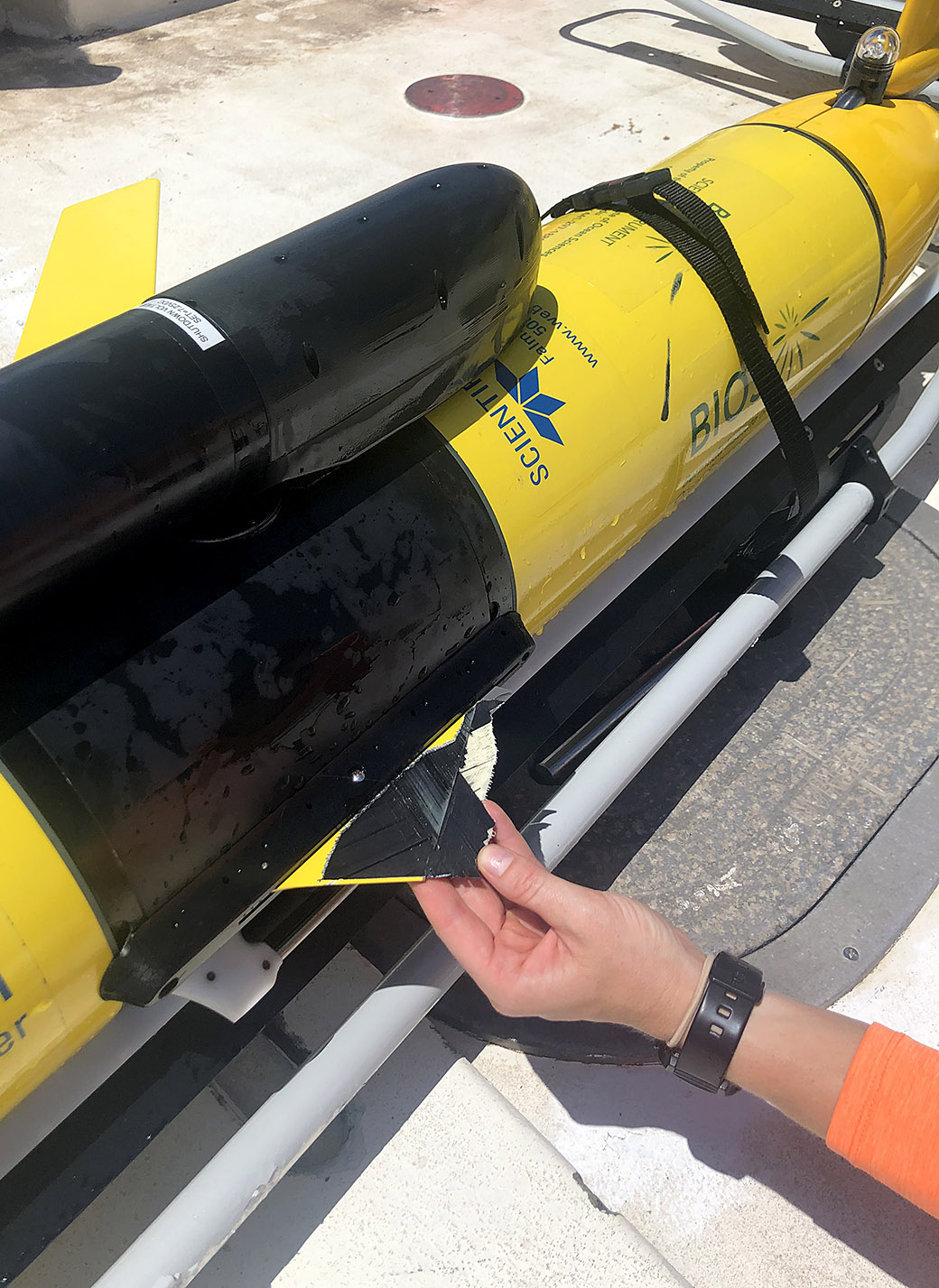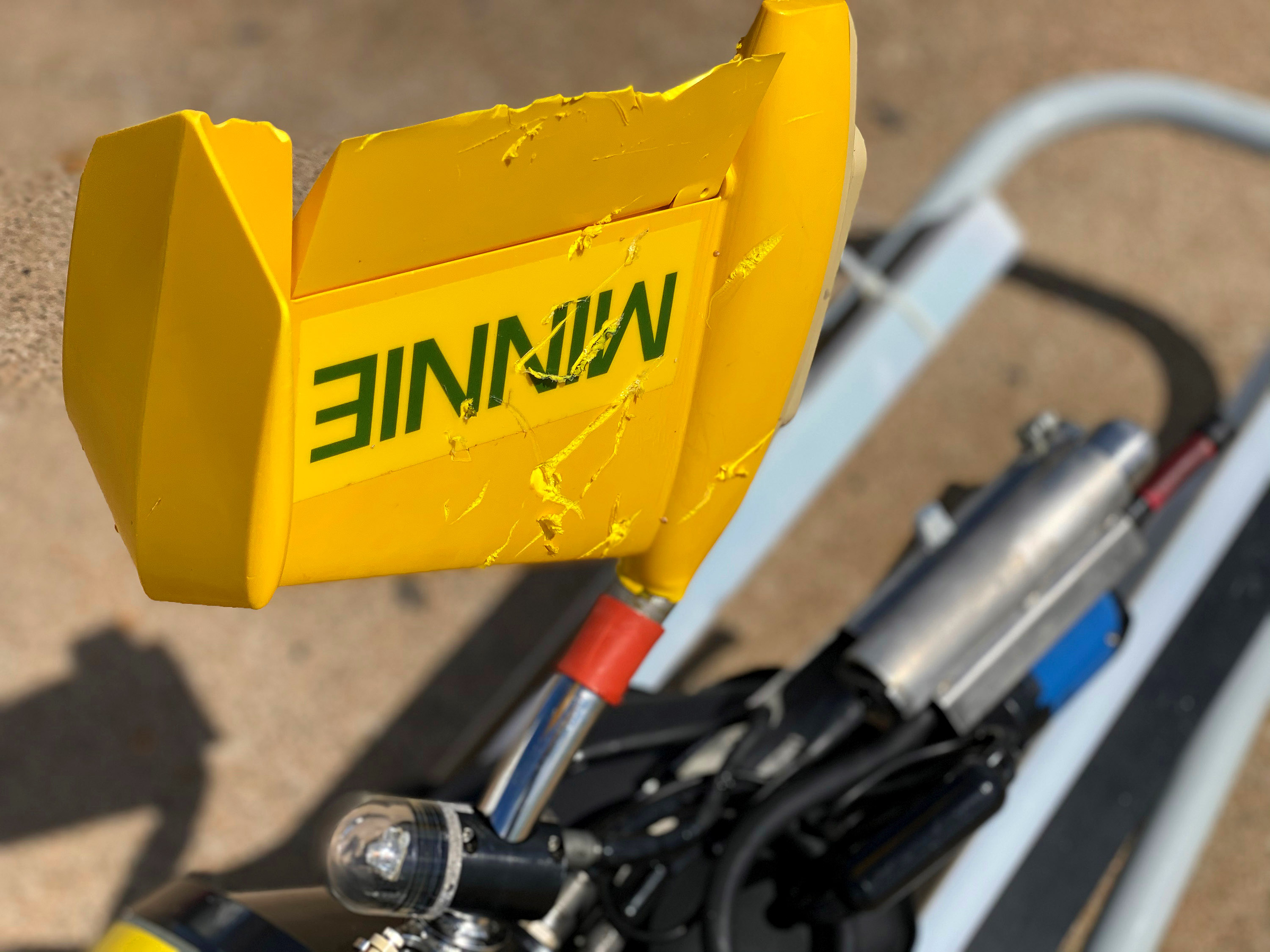In the Water Now: 16 July Update: Plagues and Predators
In March 2019, when MAGIC launched a collaborative 2-year field program combining gliders and ship-based observations to assess the strength of the biological carbon pump, no one anticipated two major problems – a global pandemic and sharks! In response to COVID-19, the U.S. wisely grounded the entire UNOLS academic research fleet, including the BIOS-operated research vessel (R/V) Atlantic Explorer last March. The timing, however—less than halfway through the planned field experiment schedule—couldn’t have been worse, as it coincided with the start of the local Spring Bloom, a scientifically critical component of the program. The science team — which includes chemical oceanographer Damian Grundle (BIOS) and marine biologist Mike Lomas (Bigelow Laboratories) — decided to pause the observations for the remainder of the year, and resume them in 2021.
The pandemic came in the wake of a series of nine mission-disrupting incidents between May 2019 and Feb 2020 that appeared to be fish attacks on the gliders. The damage ranged in severity from lost wings and broken tail rudders, which were easily replaced, to the sudden and total disappearance of our glider “Anna” on November 7, 2019. In the first five years of piloting gliders in the Sargasso Sea, the MAGIC Lab experienced just two similar encounters, although, in reality, there may have been others that did not interrupt the missions. The gliders frequently returned from duty with telltale tooth-shaped bite marks and scratches on their hull and tail sections.
Most curiously, all of the fish strikes occurred in the twilight regions of the ocean, between 240 and 800 meters, rather than in the biologically productive sunlit layers. We determined this by analyzing the gliders’ pressure profiles after recovery. In most cases, the glider’s dive or climb rate abruptly slowed (the fish holding it) or rapidly increased (glider hit from below during its climb toward the surface). Sometimes the vehicle was hit multiple times in a row. While we cannot confirm the identity of the organisms, the patterns of the bite marks suggest they are sharks, although large squid and/or dolphins might also be possibilities. A variety of shark species are known to frequent these waters, among them: great whites, makos, tiger sharks, porbeagles, and sixgills. The latest fish strike left teeth fragments embedded in the glider’s tail providing the potential to sequence DNA for a positive ID.
While it’s exciting to think about such large creatures patrolling the ocean depths, these encounters resulted in serious interruptions to sampling and, in the case of Anna, the complete loss of 2 months worth of data stored on the glider’s flash card, plus the expensive SUNA sensor the glider was carrying. The last two attacks on “Jack” and “Minnie” destroyed their tail sections, requiring costly and time-consuming repairs back at the factory.
The vehicles and sensors are insured against loss, which enabled us to purchase a replacement (“Anna2”!). The rest of the glider fleet is back in good repair, ready for action, and we have been brainstorming about ways to mitigate these fish attacks. Our leading hypothesis is that light emitted by the optical sensors – the fluorometer and the SUNA – is attracting these predators, particularly in the dark layers of the ocean. The optical fluorometer measures phytoplankton abundance while the SUNA measures nitrate concentrations, both of which are essential to the experiment. Our strategy will be to turn these sensors off when the glider is below 400 meters, and to turn them on for deeper sampling once per week. Reducing light flashes deep in the water column will hopefully keep the curious and/or hungry locals at bay.

The MAGIC gliders frequently come back from a deployment with new teeth marks on their hulls. Often these bitemarks are on the underside of the glider near the fluorometer (the circular copper puck integrated into the hull in this photo) – this sensor emits a light as it samples, which we hypothesize is attracting large predators.

A number of the fish strikes have resulted in breaking off one of the glider’s wings. The loss of a 240- gram wing changes the glider’s weight and buoyancy, causing the vertical speed to slow on dives and increase on climbs, but by adjusting the oil volume being pumped, the glider can still limp along and be steered.

In February 2020 Minnie was hit by a fish, this encounter not only left deep gouges in the glider, it also completely bent the metal rod that attaches the glider’s tail section. The tail section holds all of the glider’s communication antennas so Minnie’s tail had to be shipped back to the manufacturer to be rebuilt.

Fragments of teeth embedded in Minnie’s tail after a fish strike in February. We are hoping to sequence DNA from these fragments to identify what type of animal is hitting the gliders.

An example of shark strikes during Jack’s mission in December 2019. The interruption of the glider’s normal flight pattern is clear in the depth measurements. In this instance, the glider was hit twice in a row, about 4 minutes apart, between 610 meters and 640 meters. During the first strike, the glider was quickly moved upward through the water about 10 meters.

A sixgill shark (Hexanchus griseus), one of the multiple species suspect in the attacks on the MAGIC program’s gliders over the last two years. Teeth fragments embedded in Minnie’s tail provide the potential to sequence DNA for a positive ID. (Photo courtesy NOAA Ocean Explorer from USA/Wikimedia Commons)